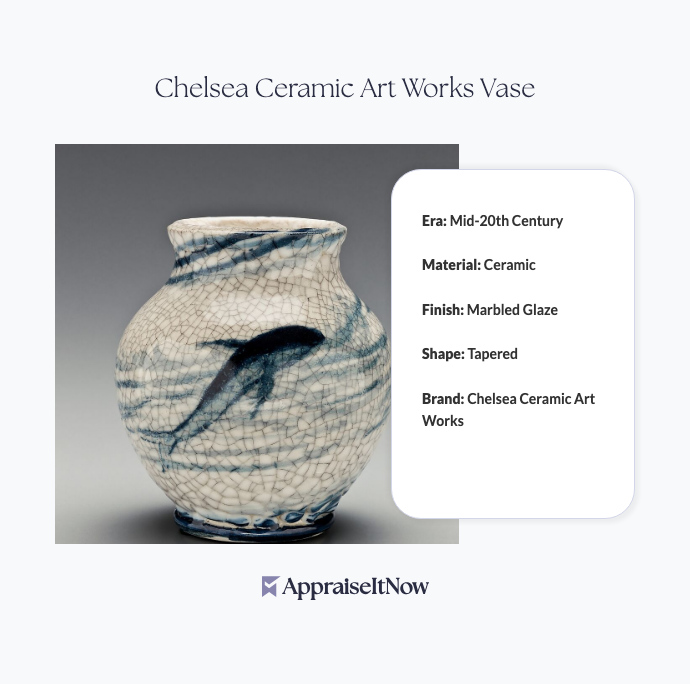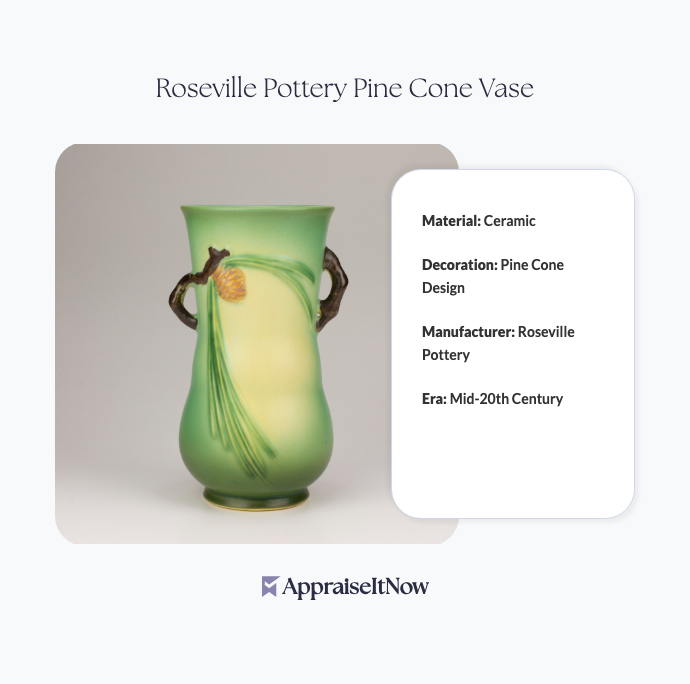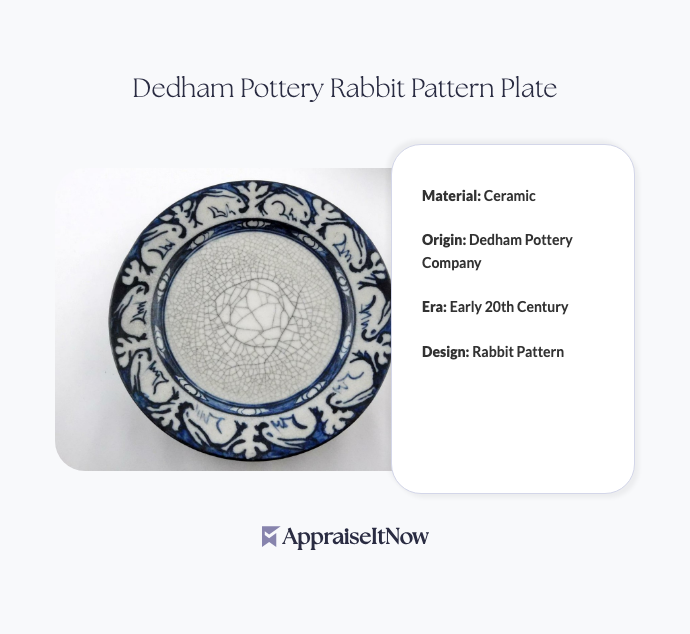<h1>How to Get Your Rookwood Pottery Standard Glaze Vase Appraised</h1>
<p>If you own a Rookwood Pottery Standard Glaze Vase, you likely recognize its exceptional craftsmanship and historical significance. Whether you're considering selling, securing insurance coverage, or simply curious about what your piece is worth, understanding how to get it appraised properly ensures you receive an accurate valuation. Current market estimates for these sought-after pieces range from <strong>$1,500 to $2,500</strong>, though individual values can vary significantly based on condition, provenance, and specific characteristics.</p>
<h2>Understanding Rookwood Pottery and Its Value</h2>
<p>Rookwood Pottery, established in <strong>1880 in Cincinnati, Ohio</strong>, revolutionized American ceramics through innovative glaze techniques and nature-inspired designs. The company's Standard Glaze—introduced alongside the company's founding—became the hallmark that defines much of Rookwood's most collectible work. Your vase represents more than decorative art; it's a documented piece of American industrial and artistic heritage.</p>
<p>The Standard Glaze technique produces a distinctive rich, even color with a smooth, silky texture that remains unmatched by contemporary pottery makers. This particular glaze method, combined with Rookwood's commitment to quality control and artistic excellence, created pieces that have appreciated substantially over the past century. Understanding this context helps when approaching professional appraisers who specialize in <a href="/types/antique-artwork">antique artwork</a> and <a href="/types/memorabilia-and-collectibles">memorabilia and collectibles</a>.</p>
<h2>What Makes Your Rookwood Vase Valuable</h2>
<p>Several factors determine where your specific piece falls within the <strong>$1,500 to $2,500</strong> valuation range. Rookwood's elegant, tapered shapes and subtle curves contribute to the timeless sophistication collectors seek, but these elements combine with measurable characteristics that professional appraisers evaluate systematically.</p>
<p>The condition of your vase significantly impacts its appraised value. Original finish integrity, absence of chips or cracks, and the vibrancy of the glaze coloring all matter considerably. A vase in excellent condition with pristine glaze might command the upper end of current market estimates, while pieces showing wear or requiring restoration fall toward the lower range. Additionally, the size and complexity of the design influence desirability—larger vases or those featuring intricate nature-inspired motifs often appraise higher than simpler examples.</p>
<p>Understanding your vase's production date requires knowledge of Rookwood's marking system. The company used distinct potter marks on the bottom of each piece, creating what collectors call "Rookwood marks." These marks tell trained appraisers valuable information about which year your vase was created, which potter decorated it, and what glaze classification applies. For comprehensive guidance on interpreting these markings, consulting resources on <a href="/blog/appraisals-for-fine-porcelain-and-ceramics-valuing-delicate-artistry">appraising fine ceramics</a> proves invaluable.</p>
<div class="callout tip"><p><strong>Pro Insight</strong></p>
<p>The number on the bottom of your Rookwood vase represents the piece's production date and sometimes the specific artisan who decorated it. This documentation dramatically enhances both historical interest and market value.</p></div>
<h2>Finding the Right Appraiser for Your Rookwood Pottery</h2>
<p>Selecting a qualified appraiser is crucial for obtaining an accurate, defensible valuation. You'll want someone with specific expertise in American art pottery and Rookwood pieces rather than a generalist appraiser. Professional appraisers specializing in <a href="/blog/appraisals-for-fine-porcelain-and-ceramics-valuing-delicate-artistry">antique ceramics</a> understand the nuanced differences between production runs, glaze variations, and artist signatures that significantly affect value.</p>
<p>Look for appraisers credentialed through recognized organizations. The American Society of Appraisers (ASA), American Association of Independent Appraisers (AAA), and International Society of Appraisers (ISA) maintain stringent member standards and USPAP-compliance requirements. <strong>AppraiseItNow</strong> connects you with certified appraisers across the U.S. who specialize in <a href="/blog/appraising-antiques-unveiling-the-hidden-treasures-in-your-collection">decorative arts and antiques</a>, ensuring your Rookwood vase receives expert evaluation.</p>
<p>When contacting potential appraisers, ask about their experience specifically with Rookwood pottery and Standard Glaze pieces. An appraiser familiar with the company's historical production patterns, glaze chemistry, and market trends provides significantly more accurate valuations than someone unfamiliar with this specialized pottery category.</p>
<h2>How Old Is Your Rookwood Pottery Vase?</h2>
<p>Determining your piece's age is one of the first steps in the appraisal process. Rookwood pottery production spans from <strong>1880 through 1967</strong> (with various periodic closures), meaning your vase could originate from any point within this nearly century-long manufacturing period. The company's founding year coincided with the emergence of the American Arts and Crafts movement, positioning Rookwood at the forefront of artistic pottery innovation.</p>
<p>Professional appraisers use several methods to authenticate and date Rookwood pieces. The marking system on the bottom of your vase provides the primary dating tool. Early Rookwood marks included impressed dates and artist monograms, while later pieces featured different marking conventions. Understanding whether your vase represents early production (1880s-1900s), middle period (1900s-1920s), or later manufacture (1920s onward) substantially affects its appraisal value. Earlier pieces generally command higher prices due to their proximity to the company's founding era and greater rarity.</p>
<h2>Documentation That Strengthens Your Appraisal</h2>
<p>When preparing your Rookwood vase for professional appraisal, gather any available documentation. This might include original purchase receipts, family provenance records, exhibition catalogs featuring your piece, or photographs from when you acquired it. Such documentation significantly strengthens your appraisal's credibility and defensibility, particularly important if you're valuing the piece for insurance or estate purposes.</p>
<p>For your appraisal submission through <strong>AppraiseItNow</strong>, photograph your vase from multiple angles including clear, well-lit images of the bottom markings. These high-resolution photographs help appraisers identify specific production details and verify authenticity before conducting a formal evaluation. Clear images of any artist signatures, glaze patterns, and the overall condition provide essential information for accurate valuation.</p>
<div class="callout note"><p><strong>Documentation Matters</strong></p>
<p>Professional appraisers can work from quality photographs and descriptions for initial consultations, though significant valuations typically require in-person examination to verify condition, glaze authenticity, and structural integrity.</p></div>
<h2>Knowing What Appraisers Look For in Ceramic Pieces</h2>
<p>Understanding the evaluation criteria helps you prepare for the appraisal process. Appraisers conducting <a href="/blog/appraisals-for-fine-porcelain-and-ceramics-valuing-delicate-artistry">professional ceramic assessments</a> examine multiple factors simultaneously. The glaze finish receives careful scrutiny—original, undisturbed glazing commands premium values, while pieces showing signs of restoration or re-glazing appraise lower. The presence of crackling or crazing in the glaze, while sometimes desirable in certain contexts, affects value depending on severity and aesthetic impact.</p>
<p>Form and design complexity matter considerably. Rookwood's most collectible pieces feature distinctive, well-executed nature-inspired motifs—flowers, birds, landscape scenes rendered in the distinctive Standard Glaze technique. The skill evident in the design's execution directly correlates with market value. Additionally, appraisers assess whether your vase shows evidence of being hand-decorated by skilled artisans, as opposed to simpler production pieces.</p>
<p>Size represents another valuation factor. Larger Rookwood vases typically command higher prices than smaller counterparts, particularly if the scale allows for more elaborate design work. However, smaller pieces with exceptional artistry can still achieve substantial values within the market.</p>
<h2>The Role of Provenance in Your Rookwood Valuation</h2>
<p>Provenance—the documented history of ownership—significantly influences how appraisers value your Rookwood vase. Pieces with clear ownership histories, particularly those from notable collections or with exhibition records, often appraise higher than pieces with unknown backgrounds. This doesn't mean your vase loses value if you lack detailed provenance, but rather that documented history provides additional support for higher valuations.</p>
<p>If you know your vase's ownership history, compile this information for your appraiser. Records showing the piece has been in a family collection for decades, or documentation of prior exhibition or publication, strengthen the valuation. When exploring <a href="/blog/exploring-the-role-of-provenance-in-art-appraisals-assessing-historical-significance">the role of provenance in art valuations</a>, you'll find that appraisers weigh these factors into their final assessments.</p>
<h2>Insurance and Replacement Value Considerations</h2>
<p>One primary reason collectors seek Rookwood appraisals involves insurance coverage. Your appraiser will determine replacement value—what it would cost to acquire a comparable piece on today's market—rather than simply historical or original purchase price. This distinction matters significantly for insurance purposes, as your policy should reflect current market conditions.</p>
<p>When submitting your Rookwood vase for appraisal through <strong>AppraiseItNow</strong>, specify whether you need replacement value for insurance, fair market value for potential sale, or estate valuation documentation. These different purposes sometimes yield different valuations, and qualified appraisers tailor their assessments accordingly.</p>
<div class="callout tip"><p><strong>Insurance Strategy</strong></p>
<p>Update your Rookwood appraisal every three to five years to reflect market changes. The ceramic and <a href="/types/memorabilia-and-collectibles">collectibles</a> markets evolve, and your insurance coverage should reflect current values.</p></div>
<h2>How Professional Appraisers Compare Your Piece</h2>
<p>Appraisers use comparable sales analysis to establish your Rookwood vase's market position. They research recent auction results, private sales, and dealer pricing for similar pieces—matching on age, size, glaze type, design complexity, and condition. This comparative methodology provides objective support for the final valuation. The $1,500 to $2,500 range reflects current market conditions, but your specific piece's position within this spectrum depends on these comparative factors.</p>
<p>Understanding what makes pottery valuable in today's market requires familiarity with collector preferences, demographic trends in the <a href="/types/memorabilia-and-collectibles">memorabilia and collectibles</a> market, and regional variations in pottery appreciation. Professional appraisers monitoring market activity provide valuations grounded in current, real-time data rather than theoretical or historical pricing.</p>
<h2>Sending Your Vase for Appraisal</h2>
<p><strong>AppraiseItNow</strong> offers a streamlined process for obtaining your Rookwood appraisal. You'll submit photographs, a detailed description including dimensions and any markings, and information about your vase's condition. Our network of credentialed appraisers specializing in <a href="/blog/unveiling-the-world-of-asian-antiques-appraising-chinese-japanese-and-southeast-asian-art">American art pottery</a> and ceramics review your submission and either provide preliminary assessment or schedule an in-person examination for more significant pieces.</p>
<p>For vases in the $1,500 to $2,500 range, most appraisers recommend in-person evaluation to verify glaze authenticity, assess condition thoroughly, and confirm production details. This personal examination creates more defensible documentation suitable for insurance claims, estate proceedings, or sale preparation.</p>
<h2>Rare Pottery Marks and Authentication</h2>
<p>Rookwood pieces sometimes feature rare marks or artist signatures that dramatically affect value. The company employed numerous artisans over its nearly century-long production, and pieces signed by particularly skilled or renowned decorators command premium prices. Conversely, understanding which marks indicate production problems or less desirable manufacturing periods helps appraisers provide accurate valuations.</p>
<p>When preparing for your appraisal, pay particular attention to any artist monograms or special markings on your vase's bottom. These details, combined with the main Rookwood mark, tell a complete story about your piece's origins and artistic significance. Professional appraisers trained in ceramic mark identification can decode this information to support their valuations.</p>
<div class="callout note"><p><strong>Key Takeaway</strong></p>
<p>Getting your Rookwood Pottery Standard Glaze Vase professionally appraised connects you with specialized expertise that accurately values your piece, documents its significance, and provides the credible valuations you need for insurance, sale, or estate planning. With current market values ranging from $1,500 to $2,500, professional appraisal ensures you understand exactly what your cherished ceramic represents in today's market.</p></div>







.avif)







